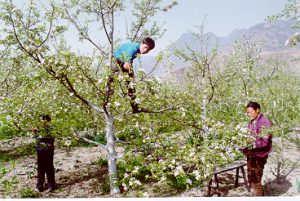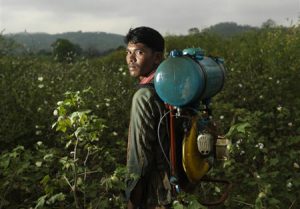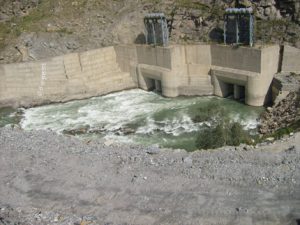The list of pesticides applied to fields in the UK is worryingly long. In order to assess their impact on bees our research team at Sussex University looked at 25 fields containing winter rapeseed or winter wheat during the 2012-13 growing season. These are perfectly normal farms; not especially intensive, situated on the edge of the South Downs in the county of Sussex, an area of gentle hills, hedgerows and wooded valleys.
Let’s look at one fairly typical field. The rapeseed crop, whose flowers the bees will feed on in season, is sown in late summer with a seed dressing containing the insecticide thiamethoxam. This is a systemic neonicotinoid, with exceedingly high toxicity to bees. Taken up into the plant, detectable levels will be in the nectar and pollen the bees gather.
In November, despite the protection supposedly offered by the neonicotinoid seed dressing the crop is sprayed with another insecticide named Gandalf which contains beta-cyfluthrin, a pyrethroid. These kinds of chemicals are highly toxic to bees and other insects – killing insects is their job, after all – but as there should be no bees about in November that isn’t supposed to be a problem.
The following May, while flowering, the crop is sprayed with another pyrethroid, alpha-cypermethrin. Only weeks later the crop is blitzed with three more pyrethroids just for good measure – why use one when three will do? The crop is still flowering at this point (it was a late year), and will be crawling with foraging bumblebees, hoverflies and other pollinators.
Between winter and summer, the crop is also treated with a barrage of herbicides, fungicides, molluscicides and fertilisers – 22 different chemicals in total. Most may have little toxicity to bees in themselves, but some, such as a group of fungicides (demethylation inhibiting or DMI fungicides), are known to interact with both neonicotinoids and pyrethroids, increasing their toxicity to bees.
So, when the fungicide prothioconazole is added to the mix tank that includes the year’s final application of chemicals, any feeding bee will be simultaneously exposed to a barrage of three pyrethroids, the thiamethoxam from the seed casing now in the nectar and pollen, and a fungicide that amplifies the toxicity of all these chemicals.
Many unknown factors
We don’t really know what impact this has. Safety tests generally expose test insects to one chemical at a time, usually for just two days, while in reality they are chronically exposed to multiple pesticides throughout their lives.
The fact that bees still live in farmland suggests they’re pretty tough, but we don’t know the effects on other pollinators or wildlife. The agrochemical industry tell us all is well, but they also tell us, and the farmers they advise, that all these applications are necessary for growing crops, and that without them food production would collapse. I have my doubts. Is this really how we want the countryside managed? Do we really want to eat food produced this way?
Fifty one years ago, Rachel Carson’s book Silent Spring highlighted the environmental damage leading from a dependence on pesticides, including poisoning farm workers with the pesticide DDT, now banned in much of the developed world. A new approach was developed, Integrated Pest Management, or IPM. More of a philosophy than a technique, IPM’s aim is to tackle pest problems using many methods, for example using pest resistant varieties, crop rotation, sacrificial trap crops, and encouraging pests’ natural enemies. Only if all else fails and pests are in sufficient number to cause significant economic damage are pesticides applied.
Everyone agreed then, and still agrees, that this is the best, most sustainable method. But while IPM of sorts is still used in some small-scale horticultural crops, mainstream arable farming has forgotten about it. Why have we gone back to prophylactic applications of dozens of different toxic chemicals?
Bad information
A lot of the blame lies with government. We used to have a number of state-funded experimental farms in the UK, where crop research was conducted, and there used to be an independent agricultural advisory service – almost all have been sold off. IPM research is not funded; instead the agrochemical industry has been allowed to fill the gap. Now, 75% of agronomists who provide advice to farmers work for agrochemical companies. Small wonder that farmers use lots of pesticides.
One major reason not to use pesticides prophylactically – that is, “in case” of pests, rather than as a response to pests – is that pests quickly grow resistant, and eventually the pesticides become useless. Overuse would seem to be a bad strategy for the agrochemical industry. But perhaps not. Each new compound is exclusively manufactured and sold by the company that developed it, but this exclusive right expires after a number of years, at which point anyone can manufacture it. The price drops, as do profits for the parent company – so it’s not so important if the pesticide has become ineffective. In fact if in the meantime they’ve developed a new product, then it is to their benefit. Not so good for farmers, on the other hand, who must pay the premium price for each new chemical generation.
It’s hard to escape the conclusion that current farming practices are not designed to benefit farmers, who pay through the nose for expensive pesticides, or consumers, who are offered expensive, pesticide-drenched food, or the environment, which is continually contaminated with a cocktail of chemicals.
It is hard to see how they are arranged for any benefit other than maximising agrochemical company profits.







